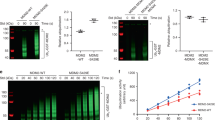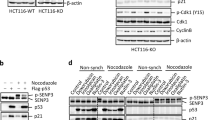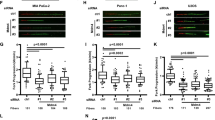Abstract
Mdm2 oncoprotein plays a major role in inhibiting the p53 tumor suppressor protein. Here, we investigate phosphorylation of Mdm2 at serine 407 (S407). S407 is phosphorylated in cells after treatment with camptothecin (CPT) or hydroxyurea, inhibitors of DNA replication. S407 phosphorylation after CPT treatment is induced upon cell cycle arrest during S phase and prevented if entry into S phase of cell cycle is blocked. We found that a major kinase responsible for S407 phosphorylation is ATR, a DNA damage checkpoint protein that induces cell cycle arrest and promotes DNA repair in response to impaired DNA replication; induction of S407 phosphorylation is enhanced after expression of wild-type ATR, while it is inhibited by a dominant-negative form of ATR. Further, S407 is specifically phosphorylated by ATR in vitro. Substitution of S407 with aspartate (S407D), but not with alanine (S407A), promotes nuclear localization of p53. Taken together, our data indicate that S407 phosphorylation of Mdm2 by ATR reduces Mdm2-dependent export of p53 from nuclei to cytoplasm.
This is a preview of subscription content, access via your institution
Access options
Subscribe to this journal
Receive 50 print issues and online access
$259.00 per year
only $5.18 per issue
Buy this article
- Purchase on Springer Link
- Instant access to full article PDF
Prices may be subject to local taxes which are calculated during checkout







Similar content being viewed by others
References
Abraham RT . (2001). Genes Dev., 15, 2177–2196.
Ashcroft M, Ludwig RL, Woods DB, Copeland TD, Weber HO, MacRae EJ and Vousden KH . (2002). Oncogene, 21, 1955–1962.
Ashcroft M, Taya Y and Vousden KH . (2000). Mol. Cell. Biol., 20, 3224–3233.
Banin S, Moyal L, Shieh S, Taya Y, Anderson CW, Chessa L, Smorodinsky NI, Prives C, Reiss Y, Shiloh Y and Ziv Y . (1998). Science, 281, 1674–1677.
Bao S, Tibbetts RS, Brumbaugh KM, Fang Y, Richardson DA, Ali A, Chen SM, Abraham RT and Wang XF . (2001). Nature, 411, 969–974.
Barak Y, Juven T, Haffner R and Oren M . (1993). EMBO J., 12, 461–468.
Blattner C, Hay T, Meek DW and Lane DP . (2002). Mol. Cell. Biol., 22, 6170–6182.
Boyd SD, Tsai KY and Jacks T . (2000). Nat. Cell Biol., 2, 563–568.
Brown EJ and Baltimore D . (2000). Genes Dev., 14, 397–402.
Burgering BM and Coffer PJ . (1995). Nature, 376, 599–602.
Canman CE, Lim DS, Cimprich KA, Taya Y, Tamai K, Sakaguchi K, Appella E, Kastan MB and Siliciano JD . (1998). Science, 281, 1677–1679.
Chehab NH, Malikzay A, Appel M and Halazonetis TD . (2000). Genes Dev., 14, 278–288.
Chehab NH, Malikzay A, Stavridi ES and Halazonetis TD . (1999). Proc. Natl. Acad. Sci. USA, 96, 13777–13782.
Cliby WA, Roberts CJ, Cimprich KA, Stringer CM, Lamb JR, Schreiber SL and Friend SH . (1998). EMBO J., 17, 159–169.
Cortez D, Wang Y, Qin J and Elledge SJ . (1999). Science, 286, 1162–1166.
Franke TF, Yang SI, Chan TO, Datta K, Kazlauskas A, Morrison DK, Kaplan DR and Tsichlis PN . (1995). Cell, 81, 727–736.
Gaiddon C, Lokshin M, Ahn J, Zhang T and Prives C . (2001). Mol. Cell. Biol., 21, 1874–1887.
Geyer RK, Yu ZK and Maki CG . (2000). Nat. Cell Biol., 2, 569–573.
Giaccia AJ and Kastan MB . (1998). Genes Dev., 12, 2973–2983.
Goldberg Z, Vogt Sionov R, Berger M, Zwang Y, Perets R, Van Etten RA, Oren M, Taya Y and Haupt Y . (2002). EMBO J., 21, 3715–3727.
Gottifredi V, Shieh S, Taya Y and Prives C . (2001). Proc. Natl. Acad. Sci. USA, 98, 1036–1041.
Gottlieb TM, Leal JF, Seger R, Taya Y and Oren M . (2002). Oncogene, 21, 1299–1303.
Gu J, Nie L, Wiederschain D and Yuan ZM . (2001). Mol. Cell. Biol., 21, 8533–8546.
Guan KL and Dixon JE . (1991). Anal. Biochem., 192, 262–267.
Hall-Jackson CA, Cross DA, Morrice N and Smythe C . (1999). Oncogene, 18, 6707–6713.
Hammond EM, Denko NC, Dorie MJ, Abraham RT and Giaccia AJ . (2002). Mol. Cell. Biol., 22, 1834–1843.
Hay TJ and Meek DW . (2000). FEBS Lett., 478, 183–186.
Henning W, Rohaly G, Kolzau T, Knippschild U, Maacke H and Deppert W . (1997). J. Virol., 71, 7609–7618.
Hirao A, Kong YY, Matsuoka S, Wakeham A, Ruland J, Yoshida H, Liu D, Elledge SJ and Mak TW . (2000). Science, 287, 1824–1827.
Juven-Gershon T and Oren M . (1999). Mol. Med., 5, 71–83.
Kastan MB and Lim DS . (2000). Nat. Rev. Mol. Cell. Biol., 1, 179–186.
Kim ST, Lim DS, Canman CE and Kastan MB . (1999). J. Biol. Chem., 274, 37538–37543.
Lane DP . (1992). Nature, 358, 15–16.
Lane DP and Hall PA . (1997). Trends Biochem. Sci., 22, 372–374.
Levine AJ . (1997). Cell, 88, 323–331.
Liu Q, Guntuku S, Cui XS, Matsuoka S, Cortez D, Tamai K, Luo G, Carattini-Rivera S, DeMayo R, Bradley A, Donehower LA and Elledge SJ . (2000). Genes Dev., 14, 1448–1459.
Lohrum MA, Woods DB, Ludwig RL, Balint E and Vousden KH . (2001). Mol. Cell. Biol., 21, 8521–8532.
Lupardus PJ, Byun T, Yee MC, Hekmat-Nejad M and Cimprich KA . (2002). Genes Dev., 16, 2327–2332.
Maya R, Balass M, Kim ST, Shkedy D, Leal JF, Shifman O, Moas M, Buschmann T, Ronai Z, Shiloh Y, Kastan MB, Katzir E and Oren M . (2001). Genes Dev., 15, 1067–1077.
Mayo LD and Donner DB . (2001). Proc. Natl. Acad. Sci. USA, 98, 11598–11603.
Momand J, Wu HH and Dasgupta G . (2000). Gene, 242, 15–29.
Nghiem P, Park PK, Kim Ys YS, Desai BN and Schreiber SL . (2002). J. Biol. Chem., 277, 4428–4434.
Oda K, Arakawa H, Tanaka T, Matsuda K, Tanikawa C, Mori T, Nishimori H, Tamai K, Tokino T, Nakamura Y and Taya Y . (2000). Cell, 102, 849–862.
Ogawara Y, Kishishita S, Obata T, Isazawa Y, Suzuki T, Tanaka K, Masuyama N and Gotoh Y . (2002). J. Biol. Chem., 277, 21843–21850.
Okamoto K, Li H, Jensen MR, Zhang T, Taya Y, Thorgeirsson SS and Prives C . (2002). Mol. Cell, 9, 761–771.
Olivier M, Eeles R, Hollstein M, Khan MA, Harris CC and Hainaut P . (2002). Hum. Mutat., 19, 607–614.
Pochampally R, Fodera B, Chen L, Lu W and Chen J . (1999). J. Biol. Chem., 274, 15271–15277.
Prives C . (1998). Cell, 95, 5–8.
Sarkaria JN, Busby EC, Tibbetts RS, Roos P, Taya Y, Karnitz LM and Abraham RT . (1999). Cancer Res., 59, 4375–4382.
Sherr CJ . (1998). Genes Dev., 12, 2984–2991.
Shieh SY, Ahn J, Tamai K, Taya Y and Prives C . (2000). Genes Dev., 14, 289–300.
Shirangi TR, Zaika A and Moll UM . (2002). FASEB J., 16, 420–422.
Siliciano JD, Canman CE, Taya Y, Sakaguchi K, Appella E and Kastan MB . (1997). Genes Dev., 11, 3471–3481.
Takimoto R and El-Deiry WS . (2001). Proc. Natl. Acad. Sci. USA, 98, 781–783.
Tao W and Levine AJ . (1999). Proc. Natl. Acad. Sci. USA, 96, 3077–3080.
Taya Y, Nakajima K, Yoshizawa-Kumagaya K and Tamai K (2003). Tumor Suppressor Genes: Methods and Protocols. El-Deiry W (ed.). Humana Press: USA, 223, 17–26.
Tibbetts RS, Brumbaugh KM, Williams JM, Sarkaria JN, Cliby WA, Shieh SY, Taya Y, Prives C and Abraham RT . (1999). Genes Dev., 13, 152–157.
Tibbetts RS, Cortez D, Brumbaugh KM, Scully R, Livingston D, Elledge SJ and Abraham RT . (2000). Genes Dev., 14, 2989–3002.
Wang H, Wang X, Zhou XY, Chen DJ, Li GC, Iliakis G and Wang Y . (2002). Cancer Res., 62, 2483–2487.
Wu X, Bayle JH, Olson D and Levine AJ . (1993). Genes Dev., 7, 1126–1132.
Xirodimas DP, Stephen CW and Lane DP . (2001). Exp. Cell Res., 270, 66–77.
Zhang Y and Xiong Y . (2001). Science, 292, 1910–1915.
Zhou BP, Liao Y, Xia W, Zou Y, Spohn B and Hung MC . (2001). Nat. Cell Biol., 3, 973–982.
Acknowledgements
The Flag-tagged ATR expression vectors are kind gifts from Robert Abraham. We are indebted to Jiangdong Chen and Christian Gaiddon for providing us the Flag-tagged Mdm2 expression vector and the HA-tagged p53 expression vector, respectively. The His-ubiquitin expression plasmid is a kind gift from Dirk Bohmann. We also thank Satomi Yamazaki for technical assistance. We thank Issei Kitabayashi for critical reading of the manuscript. This work is supported by a Grant-in Aid for Scientific Research on Priority Area from the Ministry of Education, Culture, Sports, Science and Technology of Japan, the Program for Promotion of Fundamental Studies in Health Sciences of Organization for Pharmaceutical Safety and Research of Japan, Research Grant of the Princess Takamatsu Cancer Research Fund, and Takeda Science Foundation to YT.
Author information
Authors and Affiliations
Corresponding author
Rights and permissions
About this article
Cite this article
Shinozaki, T., Nota, A., Taya, Y. et al. Functional role of Mdm2 phosphorylation by ATR in attenuation of p53 nuclear export. Oncogene 22, 8870–8880 (2003). https://doi.org/10.1038/sj.onc.1207176
Received:
Revised:
Accepted:
Published:
Issue Date:
DOI: https://doi.org/10.1038/sj.onc.1207176
Keywords
This article is cited by
-
Targeted inhibition of the ATR/CHK1 pathway overcomes resistance to olaparib and dysregulates DNA damage response protein expression in BRCA2MUT ovarian cancer cells
Scientific Reports (2023)
-
MDM2 oligomers: antagonizers of the guardian of the genome
Oncogene (2016)
-
Modeling the interplay between the HIF-1 and p53 pathways in hypoxia
Scientific Reports (2015)
-
Murine Double-Minute 2 Homolog Single Nucleotide Polymorphisms 285 and 309 in Cervical Carcinogenesis
Molecular Diagnosis & Therapy (2015)
-
GADD45β mediates p53 protein degradation via Src/PP2A/MDM2 pathway upon arsenite treatment
Cell Death & Disease (2013)



